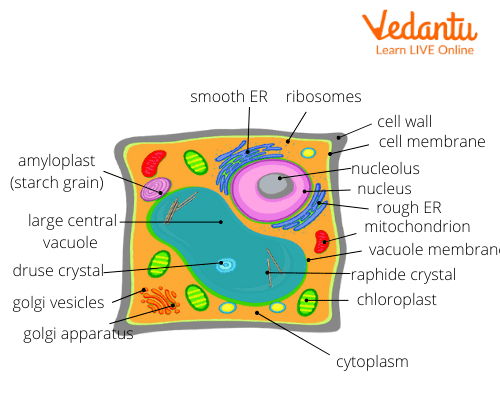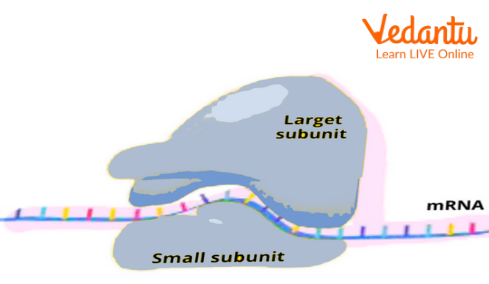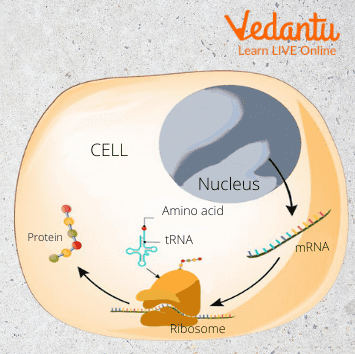




Introduction to Ribosomes in Cells
All living things, plants, animals, and even bacteria, are made up of cells. Thus, the cell is the smallest functional and structural unit of life. Each cell contains many other smaller structures which perform essential life functions. These structures are known as organelles. The nucleus (the brain of the cell) is an example of an organelle.
Ribosomes are essential organelles present in cells. In plant cells, ribosomes are located in the cytoplasm (liquid inside the cell) or attached to the cell membrane (covering of the cell). Let us read ahead to know more about ribosomes and their functions.

Ribosomes in Plant Cell
Structure of Ribosomes
Ribosomes are composed of a special type of RNA called ribosomal RNA or rRNA. They are circular in appearance under a microscope. They are granular in structure and are made up of two parts - A large subunit and a small subunit.
The ribosomal large subunit is called the 60S in plant cells and contains the area where proteins are made.
The ribosomal small subunit is called the 40S in plant cells and contains the area through which instructions about which proteins to make are received.

Structure of Ribosomes
Functions of Ribosomes
The primary function of ribosomes is to make proteins in their simplest forms - amino acids. Essentially, they act as factories of the cell. In animal cells, the function of ribosomes remains the same. As many different types of proteins need to be produced, the ribosomes get specific instructions on how to make each protein through Messenger RNA (Ribonucleic acid).
The mRNA carries these instructions in the form of a code only ribosomes understand, and this code acts as an instruction book telling the RNA how to make a specific protein. The production of amino acids begins only once the ribosome receives the start instruction (start codon). Then the ribosome moves down the mRNA reading the instructions on which amino acid to produce until it receives the stop instruction (stop codon)
The Ribosomes also help link these basic forms of proteins to help create more complex proteins. It does so by attaching one amino acid to another in specific ways to create specific proteins (amino acid chains). The way ribosomes are shaped helps them perform these functions. Due to its functions of creating amino acids from mRNA (a process called translation), ribosomes and molecules associated with it are together called the translation apparatus.

Function of Ribosomes - Translation
Few Interesting Facts about Ribosomes
Ribosomes are one of the only cell organelles found in prokaryotic cells.
Ribosomes get their name from RNA (RiboNucleic Acid).
Unlike other organelles within the cell, ribosomes do not have a protective layer or membrane.
They are produced in the nucleolus within the nucleus of the cell.
They are also found attached to the surface of the Rough Endoplasmic Reticulum.
They are also called Palade Granules after the scientist who discovered them - George Palade.
Summary
Ribosomes are small circular organelles found in the cell. They have two subparts - 60S and 40S. In simple words, their function is protein synthesis. They act like factories for the cell as they produce specific amino acids as per instructions given to them by mRNA. They also join these amino acids to create complex proteins. This was the discussion about ribosomes. We hope you liked reading about it. You can head to our website to read more about such interesting Science topics.
FAQs on Function and Structure of Ribosomes in Plant Cell
1. What is the function of ribosomes, and how do they perform these functions?
Ribosomes are responsible for creating amino acids. They act as factories of the cell. These amino acids are created by ribosomes using specific instructions given to them through messenger RNA (mRNA). The two subunits of the ribosome come together along with RNA to produce specific amino acids. The structure of the ribosome also helps in the production of the amino acids as well as in linking them together to create complex proteins. The proteins created by the ribosomes are responsible for various life-sustaining functions.
2. Why are ribosomes found in prokaryotic cells even though other cell organelles are absent?
Prokaryotic cells do not contain any membrane-bound cell organelles like mitochondria. However, these cells do contain ribosomes, which float freely in the cytoplasm of the cell. Prokaryotic cells contain ribosomes as ribosomes are the only organelle capable of producing and linking amino acids to form complex proteins. The proteins formed by ribosomes are essential as they are involved in many reactions that take place within the cell. Without proteins, life-sustaining functions cannot be performed. Thus, without ribosomes, prokaryotic cells would not be able to survive.
3. Why is the ribosome important?
The main function of ribosomes is to produce proteins that are used both inside the cell and sent outside the cell. Without ribosomes, the human body would not be able to produce the proteins it needs to survive and metabolism would come to a grinding halt.









